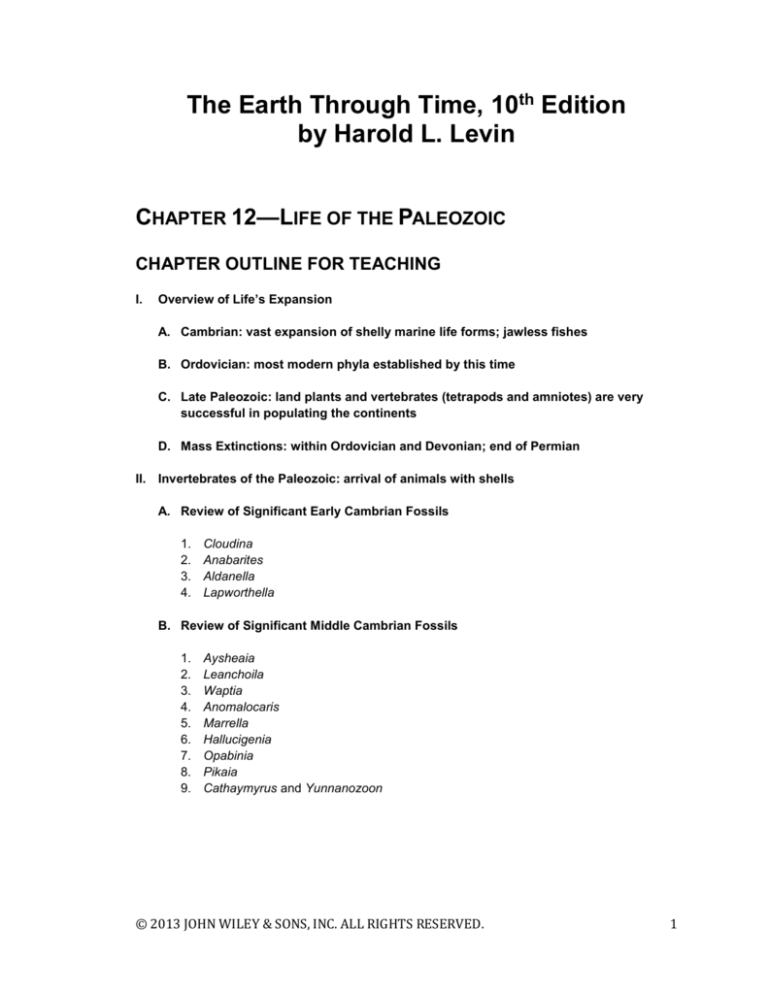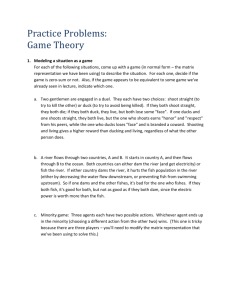
The Earth Through Time, 10th Edition
by Harold L. Levin
CHAPTER 12—LIFE OF THE PALEOZOIC
CHAPTER OUTLINE FOR TEACHING
I.
Overview of Life’s Expansion
A. Cambrian: vast expansion of shelly marine life forms; jawless fishes
B. Ordovician: most modern phyla established by this time
C. Late Paleozoic: land plants and vertebrates (tetrapods and amniotes) are very
successful in populating the continents
D. Mass Extinctions: within Ordovician and Devonian; end of Permian
II. Invertebrates of the Paleozoic: arrival of animals with shells
A. Review of Significant Early Cambrian Fossils
1.
2.
3.
4.
Cloudina
Anabarites
Aldanella
Lapworthella
B. Review of Significant Middle Cambrian Fossils
1.
2.
3.
4.
5.
6.
7.
8.
9.
Aysheaia
Leanchoila
Waptia
Anomalocaris
Marrella
Hallucigenia
Opabinia
Pikaia
Cathaymyrus and Yunnanozoon
© 2013 JOHN WILEY & SONS, INC. ALL RIGHTS RESERVED.
1
C. Extraordinary Cambrian Soft-Body Fossil Sites
1. Burgess Shale, British Columbia, Canada
a. viewed as one of the most important faunas in fossil record
b. impressions and films on bedding planes
c. limited exposure near Mt. Wapta, BC
d. discovered by C.D. Walcott in 1909
e. four groups of arthropods (trilobites, crustaceans, scorpions, insects)
f. other groups: sponges, onycophorans, crinoids, sea cucumbers, chordates, other
unknown forms
2. Chengjian site, Yunnan Province, China
a. about 10 million years older than Burgess Shale
b. discovered in 1984
c. early chordates and oldest fishes
D. The Cambrian explosion of life
1. Sudden increase in the pace of evolution
2. Possible causes
a. more beneficial climatic conditions following glacial episodes and the related
demise of the Ediacaran animals
b. changes in the sequences of HOX genes that control body architecture
c. combination of factors, some of which may not be known
E. The Great Ordovician Biodiversification Event (GOBE)
1. Middle Ordovician, only 40 million years after the Cambrian explosion
2. Tripling of global biodiversity in only 25 million years
3. Accompanied fragmentation of continents and proliferation of shallow, warm water
habitats
4. New groups
a. trilobites
b. brachipods
c. bivalve mollusks
d. gastropods
e. coralline animals
5. Newly diverse life strategies
a. epifaunal and infaunal
b. filter and sediment feeding
c. herbivores, carnivores, and scavengers
III. Invertebrates of the Paleozoic
A. Diversification of Many Groups
1.
2.
3.
4.
Epifaunal animals
Infaunal animals (bioturbation)
Filter-feeding animals
Sediment-feeding animals
© 2013 JOHN WILEY & SONS, INC. ALL RIGHTS RESERVED.
2
B. Unicellular Groups
1. Foraminifera (calcareous microfossils)
a. range Cambrian to present
b. more numerous and varied by Carboniferous
c. global distribution during Pennsylvanian-Permian (fusulinids)
2. Radiolarians (siliceous microfossils)
a. range Early Paleozoic to present
b. most abundant in Mesozoic rocks
C. Marine Invertebrate Groups
1. Colonial cup animals
a. archaeocyathids
b. sponges (Porifera)
(i) well-known guide fossils
Cambrian: Protospongia
Silurian: Astraeospongium
Devonian: Hydnoceras
(ii) sponge-like fossils: stromatoporoids
c. corals and other cnidarians
(i) rugose or tetracorals
(ii) scleractinid or hexacorals
(iii) tabulates
2. Bryozoans
3. Brachiopods
a. articulate
b. inarticulate
4. Mollusks
a. placophorans
b. monoplacophorans
c. bivalvia or pelecypoda
(i) clams
(ii) mussels
(iii) scallops
(iv) oysters
d. gastropods
e. cephalopods
5. Arthropods
a. trilobites
b. ostracods
c. eurypterids
6. Echinoderms
a. asteroidea (starfish)
b. ophiuroidea (brittle stars)
c. echinoidea (sea urchins)
d. edioasteroidea (ancestral starfish and sea urchins)
e. crinoidea (crinoids)
© 2013 JOHN WILEY & SONS, INC. ALL RIGHTS RESERVED.
3
f. cystoidea (cystoids)
g. blastoidea (blastoids)
h. rhombifera
i. diploporita
7. Graptolites: primitive chordates called pterobranchs
IV. Vertebrates (Chordates) of the Paleozoic
A. Basic Groups
1. Non-Amniotic vertebrates
a. fish and amphibians
b. require water to reproduce
2. Amniotic vertebrates
a. all higher vertebrates
b. have enclosed eggs
3. Chordates
a. stiff, elongate support structure with central nerve cord
b. gill slits and ventral and dorsal blood circulation
B. Fishes: five taxonomic classes
1. Agnathids (jawless fish): ostracoderms
2. Acanthodians and Placoderms (archaic jawed fish)
a. placoderms
b. arthrodires
c. antiarchs
3. Chondrichthyans (cartilaginous fish)
4. Osteichthyans (bony fish)
a. actinopterygians (ray-fined fish)
b. sarcopterygians (lobe-finned fish)
(i) dipnoans (lungfish)
(ii) crossopterygians (lobe-finned fish with limbs)
rhipidistians
coelacanths
C. Conodont elements (microfossil teeth)
1. Range: Late Paleozoic-Triassic
2. Fossil hard parts: tooth-like calcium phosphate fossils
3. Whole body form: eel-like, 40 mm long, a primitive jawless vertebrate with many teeth
(Promissum)
D. Crossopterygians: transitional animals between fish and amphibians that had
forelimbs
1. Tiktaalik
2. Eusthenopteron
© 2013 JOHN WILEY & SONS, INC. ALL RIGHTS RESERVED.
4
E. Tetrapods
1. Amphibians (egg-laying tetrapods that reproduce in water)
a. ichthyostegids: fish-like amphibians (basal tetrapods)
b. labyrinthodonts: teeth similar to ray-fin fishes
2. Reptiles, Birds, and Mammals (Amniotic tetrapods)
a. Late Carboniferous subdivision
(i) reptiles
(ii) synapsids
b. Permian-Triassic groups
(i) therapsids (mammal-like reptiles)
(ii) cynodonts (an especially mammal-like group)
V. Plants of the Paleozoic
A. Stromatolites and stromatolitic reefs: Cambrian-Ordovician
B. Non-stromatolitic algae of Early Paleozoic
1. Chlorophytes
2. Receptaculids (lime-secreting algae sometimes called “sunflower corals”)
C. Land plants
1. Bryophytes (mosses, liverworts, hornworts)
2. Tracheophytes (ferns and trees)
a. lycopsids (scale trees)
(i) Lepidodendron
(ii) Sigillaria
b. cordaites
VI. Mass Extinctions
A. Late Ordovician: global cooling event due to Gondwanaland’s ice caps
1. Phase-one victims: planktonic and nektonic organisms (graptolites, acritarchs, and
many nautloids)
a. associated with global cooling, which shifted living groups toward the equator
b. sea level was lowered and epeiric seas and shallow shelf areas lost due to
regression
2. Phase-two victims: benthic organisms (surviving trilobites; great reduction in numbers
of corals, conodonts, bryozoans, and brachiopods)
a. associated with global cooling
b. sea level rising due to ice-sheet melting
c. warmer conditions stressed cold-adapted groups
© 2013 JOHN WILEY & SONS, INC. ALL RIGHTS RESERVED.
5
B. Late Devonian: global cooling due to Gondwanaland glaciation
1. Decimated Devonian reef communities including tabulate corals and stromatoporoids
2. Severely reduced: rugose corals, brachiopods, goniatites, trilobites, conodonts, and
placoderms
3. Marine invertebrates in general: loss of 70% of families
4. Occurred over 20 million years, therefore an ecological crisis of some kind
a. eutrophication or anoxic conditions in the oceans
b. continental glaciation: cooling and regression of seas
C. Late Permian (“Mother of Mass Extinctions”)
1. Continental effects
a. 70% of land animal species exterminated
b. extinction of families of amphibians, primitive reptiles, mammal-like reptiles
2. Marine effects
a. most strongly affected the tropics
b. 90% of marine species exterminated
c. extinction of fusulinids, rugose corals, many crinoids, productid brachiopods, lacy
bryozoans, many ammonoid groups
3. Factors
a. extreme global warming
b. greenhouse gas effects
c. massive flood basalt eruptions
d. carbon-dioxide poisoning
e. ozone layer damage or loss
Answers to Discussion Questions
1. In the Burgess Shale, Pikaia is a chordate. In the Chengjian site, China, Cathysmyrus and
Yunnanozoon are chordates. Chordates have a notochord (at some stage of development)
and a related nerve cord on the dorsal side of the notochord. Fossils with evidence of these
features are classified as chordates.
2. Here are the age assignments of the fossils indicated:
fusulinids
archaeocyathids
Archimedes
Pennsylvanian-Permian
Early-Middle Cambrian
Mississippian
3. The presence of stinging cells, or cnidocytes, characterizes all members of the Phylum
Cnidaria, and thus the phylum is so named. The extinct forms are tabulate and rugose corals.
4. Cephalopods of the Subclass Nautiloidea have straight or gently undulating sutures,
whereas the Ammonoidea have more complex sutures.
© 2013 JOHN WILEY & SONS, INC. ALL RIGHTS RESERVED.
6
5. Conodont elements consist of cones, bars, and blades bearing tiny denticles or cusps.
These elements are made of calcium phosphate (a variety of the mineral apatite), a material
common in teeth of vertebrates.
6. By the end of Paleozoic, many invertebrate groups had become extinct, including fusulinids,
rugose corals, many families of crinoids, productid brachiopods, trilobites, lacy bryozoans,
and many groups of ammonoids.
7. Shallow shelf and epeiric sea environments are affected by episodes of continental glaciation
when sea level is lowered due to ice buildup at high latitude. Cooling of water also makes
calcium carbonate precipitation move difficult, so the amount of carbonate deposition is
greatly decreased.
8. Echinoderms are largely sessile spiny skinned animals which generally consist of a crown,
stem, and arms. Trilobites are mobile, three-lobed arthropods which were highly successful
Paleozoic animals, but are extinct today. Mollusks are a diverse group which all have in
common a foot and a mantle (which secrets shell, if any). The Mollusks have various
strategies of life: infaunal, epifaunal, and mobile. The Brachiopods are symmetrical bivalves
that are filter feeders. The Brachiopods still exist but were at their peak of diversity during
Paleozoic. The Bryozoa are colonial organisms consisting of collections of zooecia; they
generally form branching or encrusting shapes. The Porifera (sponges) consist mainly of an
osculum, choanocytes, mesenchyme, and flagellae. The Porifera are attached forms; their
fossil record is mainly as spicules of silica or calcium carbonate.
9. Evolution of the shell provided obvious physical protection for the invertebrate. Further, the
shell permitted more efficient locomotion in water and sediment.
10. (a) Ostracaderms and placoderms – The former are Early Paleozoic armored, jawless fishes
(Agnatha), and the latter, armored jawed fishes.
(b) Osteichthyes and chondrichthyes – The former are bony fishes, and the latter,
cartilaginous fishes
(e.g., sharks).
(c) Sarcopterygians and labyrinthodonts – The former are lobe-finned fish, and the latter, a
lung fish with specialized teeth made of infolded enamel.
(d) Infaunal and epifaunal invertebrates – The former live within sediment or rock, and
the latter, upon sediment or rock.
(e) Synapsids and diapsids – The former type of tetrapod has one temporal fenestra
(opening) on each side of the skull, and the latter, two fenestra on each side.
11. Tiktaalik was a transitional animal between fish and amphibians that had forelimbs. These
forelimbs had the beginnings of fingers, wrist bones, elbows, and shoulders. The upper arm
(humurus) resembled both that of the fish and the amphibian.
12. Therapsid reptile characteristics indicating eventual mammalian evolution include: fewer
bones in the skull, enlarged lower jaw at the expense of more posterior elements, double balland-socket articulation of skull and neck, differentiation of teeth (incisors, canines, cheek,
teeth), limbs indirect vertical alignment beneath body, and ribs reduced in neck and lumber
region (promoting flexibility).
© 2013 JOHN WILEY & SONS, INC. ALL RIGHTS RESERVED.
7
13. Chlorophytes, or green algae, are considered ancestral to land plants because of
chlorophytes’ adaptation to freshwater and presence of chlorophyll (green pigment).
14. The vascular system in plants was a key step in evolution of land-dwelling species because it
allowed conduction of water and dissolved minerals and gave strength to the plant so it could
withstand gravity’s force and wind. The first plant to make this transition was Cooksonia,
small, leafless stems that were thin and evenly branching (with branches surmounted by
sporangia). Aglaophyton and Rhynia which followed had woody, vascular tissue.
15. Synapsid reptiles have a single, lower temporal opening (fenestra) on each side of
skull.
the
16. a and e
17. a
18. b and c
19. d
20. d
21. e
22. b
23. a
24. d
25. e
26. a
Chapter Activities
Student activities for in-depth learning.
1. Using the resources on Anomalocaris at http://www.trilobites.info/anohome.html, write a
description of this unusual looking arthropod. In your description, note what uses the various
features of Anomalocaris’ body plan might have been. Make a sketch of Anomalocaris and label
the parts. When did this arthropod live and where has it been found?
2. Use the web resources at the web pages on placoderms located at the University of California,
Berkeley, Museum of Paleontology web site as follows: http://www.ucmp.berkeley.edu/
vertebrates/basalfish/placodermi.html. What is the nature of a placoderm? What is the geological
range of this fish? Make a sketch of the bony skull of the placoderm. Why was bony armor of
importance to such fish at this time in geological history?
© 2013 JOHN WILEY & SONS, INC. ALL RIGHTS RESERVED.
8









